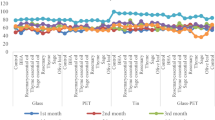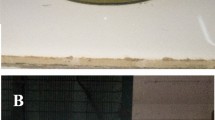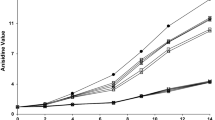Abstract
Introduction
Mayonnaise is an oil in water emulsion (O/W) consisting 70–80% oil. Lipid oxidation is a major cause of quality deterioration in mayonnaise. The effectiveness of antioxidants in a hetrophasic systems is highly dependent on their polarity and partitioning properties.
Objectives
The aim of the present study was to determine the effect of a hydrophilic [green tea extract (GTE)] and a lipophilic [tocopherol mixture (TOC)] and BHA on lipid oxidation in mayonnaise during 60 days of storage at 38 °C and to examine the interactions between GTE and TOC, to determine possible synergistic or antagonistic effects in antioxidant activity.
Methods
The oxidative stability was studied by measuring hydroperoxides, volatile organic compounds (VOCs) and colour of mayonnaise during storage. Comprehensive analysis of VOCs was done by static headspace extraction and separation by two-dimensional gas chromatography time of flight mass spectrometry. Sensory analysis was also carried out to study the effect of storage time and antioxidant type on sensory properties of mayonnaise and to investigate the predictive ability of volatile compounds for sensory terms.
Results and conclusion
Addition of GTE (500 ppm) and TOC (500 ppm) increased the formation of hydroperoxides and certain VOCs. The combination of GTE with TOC improved the antioxidant efficacy compared to the individual extracts. However, sensory evaluation demonstrated that GTE promoted the development of unpleasant fishy and rancid aroma. The volatile compound methional, was significantly and positively correlated with fishy and rancid flavour. Regarding colour analysis, GTE showed the highest increase in darkening and browning during storage.




Similar content being viewed by others
References
Buettner, G. R. (1993). The pecking order of free radicals and antioxidants: Lipid peroxidation, α-tocopherol, and ascorbate. Archives of Biochemistry and Biophysics, 300, 535–543.
Chen, B., Rao, J., Ding, Y., McClements, D. J., & Decker, E. A. (2016). Lipid oxidation in base algae oil and water-in-algae oil emulsion: Impact of natural antioxidants and emulsifiers. Food Research International, 85, 162–169.
Chen, Z., & Chan, P. (1996). Antioxidative activity of green tea catechins in canola oil. Chemistry and Physics of Lipids, 82, 163–172.
Concepcion, J. C. T., Ouk, S., Riedel, A., Calingacion, M., Zhao, D., Ouk, M., et al. (2018). Quality evaluation, fatty acid analysis and untargeted profiling of volatiles in Cambodian rice. Food Chemistry, 240, 1014–1021.
Coupland, J. N., & McClements, D. J. (1996). Lipid oxidation in food emulsions. Trends in Food Science & Technology, 7, 83–91.
Danh, L. T., Triet, N. D. A., Zhao, J., Mammucari, R., & Foster, N. (2012). Antioxidant activity, yield and chemical composition of lavender essential oil extracted by supercritical CO2. The Journal of Supercritical Fluids, 70, 27–34.
Daygon, V. D., Prakash, S., Calingacion, M., Riedel, A., Ovenden, B., Snell, P., et al. (2016). Understanding the Jasmine phenotype of rice through metabolite profiling and sensory evaluation. Metabolomics, 12, 63.
Durand, E., Zhao, Y., Coupland, J. N., & Elias, R. J. (2015). Assessing interactions between lipophilic and hydrophilic antioxidants in food emulsions. Journal of Agricultural and Food Chemistry, 63, 10655–10661.
Frankel, E. N., Huang, S.-W., & Aeschbach, R. (1997). Antioxidant activity of green teas in different lipid systems. Journal of the American Oil Chemists’ Society, 74, 1309–1315.
Frankel, E. N., Huang, S.-W., Kanner, J., & German, J. B. (1994). Interfacial phenomena in the evaluation of antioxidants: bulk oils vs emulsions. Journal of Agricultural and Food Chemistry, 42, 1054–1059.
Ghorbani Gorji, S., Smyth, H. E., Sharma, M., & Fitzgerald, M. (2016). Lipid oxidation in mayonnaise and the role of natural antioxidants: A review. Trends in Food Science & Technology, 56, 88–102.
Guillén, M. D., Cabo, N., Ibargoitia, M. L., & Ruiz, A. (2005). Study of both sunflower oil and its headspace throughout the oxidation process. Occurrence in the headspace of toxic oxygenated aldehydes. Journal of Agricultural and Food Chemistry, 53, 1093–1101.
Ho, C.-T., Zheng, X., & Li, S. (2015). Tea aroma formation. Food Science and Human Wellness, 4, 9–27.
Huang, S.-W., & Frankel, E. N. (1997). Antioxidant activity of tea catechins in different lipid systems. Journal of Agricultural and Food Chemistry, 45, 3033–3038.
Jacobsen, C., Adler-Nissen, J., & Meyer, A. S. (1999a). Effect of ascorbic acid on iron release from the emulsifier interface and on the oxidative flavor deterioration in fish oil enriched mayonnaise. Journal of Agricultural and Food Chemistry, 47, 4917–4926.
Jacobsen, C., Hartvigsen, K., Lund, P., Adler-Nissen, J., Holmer, G., & Meyer, A. S. (2000). Oxidation in fish-oil-enriched mayonnaise 2. Assessment of the efficacy of different tocopherol antioxidant systems by discriminant partial least squares regression analysis. European Food Research and Technology, 210, 0242–0257.
Jacobsen, C., Hartvigsen, K., Lund, P., Meyer, A. S., Adler-Nissen, J., Holstborg, J., et al. (1999b). Oxidation in fish-oil-enriched mayonnaise 1. Assessment of propyl gallate as an antioxidant by discriminant partial least squares regression analysis. European Food Research and Technology, 210, 13–30.
Jacobsen, C., Hartvigsen, K., Lund, P., Thomsen, M. K., Skibsted, L. H., Hølmer, G., et al. (2001a). Oxidation in fish oil-enriched mayonnaise: 4. Effect of tocopherol concentration on oxidative deterioration. European Food Research and Technology, 212, 308–318.
Jacobsen, C., Hartvigsen, K., Thomsen, M. K., Hansen, L. F., Lund, P., Skibsted, L. H., et al. (2001b). Lipid oxidation in fish oil enriched mayonnaise: Calcium disodium ethylenediaminetetraacetate, but not gallic acid, strongly inhibited oxidative deterioration. Journal of Agricultural and Food Chemistry, 49, 1009–1019.
Jacobsen, C., Schwarz, K., Stöckmann, H., Meyer, A. S., & Adler-Nissen, J. (1999c). Partitioning of selected antioxidants in mayonnaise. Journal of Agricultural and Food Chemistry, 47, 3601–3610.
Jayasinghe, C., Gotoh, N., & Wada, S. (2013). Pro-oxidant/antioxidant behaviours of ascorbic acid, tocopherol, and plant extracts in n-3 highly unsaturated fatty acid rich oil-in-water emulsions. Food Chemistry, 141, 3077–3084.
Kalua, C., Allen, M., Bedgood, D., Jr., Bishop, A., Prenzler, P. D., & Robards, K. (2007). Olive oil volatile compounds, flavour development and quality: A critical review. Food Chemistry, 100, 273–286.
Karahadian, C., & Lindsay, R. C. (1989). Action of tocopherol-type compounds in directing reactions forming flavor compounds in autoxidizing fish oils. Journal of the American Oil Chemists’ Society, 66, 1302–1308.
Keszler, Á., Kriska, T., & Németh, A. (2000). Mechanism of volatile compound production during storage of sunflower oil. Journal of Agricultural and Food Chemistry, 48, 5981–5985.
Kochhar, S. (1996). Oxidative pathways to the formation of off-flavours. In Food taints and off-flavours. Springer.
Let, M. B., Jacobsen, C., & Meyer, A. S. (2007). Ascorbyl palmitate, γ-tocopherol, and EDTA affect lipid oxidation in fish oil enriched salad dressing differently. Journal of Agricultural and Food Chemistry, 55, 2369–2375.
Matheis, K., Granvogl, M., & Schieberle, P. (2016). Quantitation and enantiomeric ratios of aroma compounds formed by an Ehrlich degradation of l-isoleucine in fermented foods. Journal of Agricultural and Food Chemistry, 64, 646–652.
Nissen, L. R., Byrne, D. V., Bertelsen, G., & Skibsted, L. H. (2004). The antioxidative activity of plant extracts in cooked pork patties as evaluated by descriptive sensory profiling and chemical analysis. Meat Science, 68, 485–495.
Nourooz-Zadeh, J., Tajaddini-Sarmadi, J., Birlouez-Aragon, I., & Wolff, S. P. (1995). Measurement of hydroperoxides in edible oils using the ferrous oxidation in xylenol orange assay. Journal of Agricultural and Food Chemistry, 43, 17–21.
Panya, A., Kittipongpittaya, K., Laguerre, M., Bayrasy, C., Lecomte, J., Villeneuve, P., et al. (2012). Interactions between α-tocopherol and rosmarinic acid and its alkyl esters in emulsions: Synergistic, additive, or antagonistic effect? Journal of Agricultural and Food Chemistry, 60, 10320–10330.
Rizner, A., Hadolin, M., Knez, Z., & Bauman, D. (2000). Comparison of antioxidative and synergistic effects of rosemary extract with a-tocopherol, ascorbyl palmitate and citric acid in sunflower oil. Food Chemistry, 71, 229–233.
Sainsbury, J., Grypa, R., Ellingworth, J., Duodu, K. G., & De Kock, H. L. (2016). The effects of antioxidants and shelf life conditions on oxidation markers in a sunflower oil salad dressing emulsion (SOSDE). Food Chemistry, 213, 230–237.
Soncu, E. D., & Kolsarici, N. (2017). Microwave thawing and green tea extract efficiency for the formation of acrylamide throughout the production process of chicken burgers and chicken nuggets. Journal of the Science of Food and Agriculture, 97, 1790–1797.
Sørensen, A.D.M., Villeneuve, P., & Jacobsen, C. (2017). Alkyl caffeates as antioxidants in O/W emulsions: Impact of emulsifier type and endogenous tocopherols. European Journal of Lipid Science and Technology 119.
Tikapunya, T., Henry, R. J., & Smyth, H. (2018). Evaluating the sensory properties of unpolished Australian wild rice. Food Research International, 103, 406–414.
Timm-Heinrich, M., Xu, X., Nielsen, N. S., & Jacobsen, C. (2004). Oxidative stability of mayonnaise and milk drink produced with structured lipids based on fish oil and caprylic acid. European Food Research and Technology, 219, 32–41.
Wanasundara, U. N., & Shahidi, F. (1998). Antioxidant and pro-oxidant activity of green tea extracts in marine oils. Food Chemistry, 63, 335–342.
Worrasinchai, S., Suphantharika, M., Pinjai, S., & Jamnong, P. (2006). β-Glucan prepared from spent brewer’s yeast as a fat replacer in mayonnaise. Food Hydrocolloids, 20, 68–78.
Yin, J., Becker, E. M., Andersen, M. L., & Skibsted, L. H. (2012). Green tea extract as food antioxidant. Synergism and antagonism with α-tocopherol in vegetable oils and their colloidal systems. Food Chemistry, 135, 2195–2202.
Zhou, L., & Elias, R. J. (2013). Antioxidant and pro-oxidant activity of (−)-epigallocatechin-3-gallate in food emulsions: Influence of pH and phenolic concentration. Food Chemistry, 138, 1503–1509.
Zhou, L., Zhao, M., Bindler, F., & Marchioni, E. (2014). Comparison of the volatiles formed by oxidation of phosphatidylcholine to triglyceride in model systems. Journal of Agricultural and Food Chemistry, 62, 8295–8301.
Zou, X.-G., Chen, X.-L., Hu, J.-N., Wang, Y.-F., Gong, D.-M., Zhu, X.-M., et al. (2017). Comparisons of proximate compositions, fatty acids profile and micronutrients between fiber and oil flaxseeds (Linum usitatissimum L.). Journal of Food Composition and Analysis, 62, 168–176.
Acknowledgements
The authors would like to acknowledge Mary Sharma, Adam Mayne and Goodman Fielder Company for supplying the ingredients and production of samples. The authors thank the sensory evaluation panel of the Health and Food Sciences Precinct, Coopers Plains, Australia for their dedication.
Funding
This study was funded by the Industry Transformation Training Centre Australian Research Council Project, ARC: IC130100011 and The University of Queensland.
Author information
Authors and Affiliations
Contributions
MF and SGG designed the study. SGG performed all experiments, interpreted data and wrote the manuscript. MC, MF designed and participated in the interpretation of the GC × GC/TOF–MS test. HES designed the sensory test and participated in the data interpretation. The paper was edited by all. All authors read and approved the manuscript.
Corresponding author
Ethics declarations
Conflict of interest
All authors declare that no conflict of interest exists.
Ethical approval
This study was conducted under the Human Ethics Approval # 2015001700. All procedures for conducting the sensory analysis were in accordance with the ethical standards of the institutional and/or national research committee and with the 1964 Helsinki declaration and its later amendments or comparable ethical standards.
Informed consent
Informed consent was obtained from all individual participants included in the study.
Additional information
Publisher's Note
Springer Nature remains neutral with regard to jurisdictional claims in published maps and institutional affiliations.
Electronic supplementary material
Below is the link to the electronic supplementary material.
Rights and permissions
About this article
Cite this article
Ghorbani Gorji, S., Calingacion, M., Smyth, H.E. et al. Effect of natural antioxidants on lipid oxidation in mayonnaise compared with BHA, the industry standard. Metabolomics 15, 106 (2019). https://doi.org/10.1007/s11306-019-1568-4
Received:
Accepted:
Published:
DOI: https://doi.org/10.1007/s11306-019-1568-4




